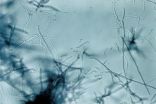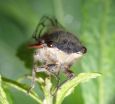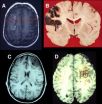(Press-News.org) August 28, 2014 — (BRONX, NY) — Researchers from Albert Einstein College of Medicine of Yeshiva University and other institutions have developed a potential antibody therapy for Sudan ebolavirus (SUDV), one of the two most lethal strains of Ebola. A different strain, the Zaire ebolavirus (EBOV), is now devastating West Africa. First identified in 1976, SUDV has caused numerous Ebola outbreaks (most recently in 2012) that have killed more than 400 people in total. The findings were reported in ACS Chemical Biology.
Between 30 and 90 percent of people infected with Ebola die after experiencing symptoms of the disease that include fever, muscle aches, vomiting and bleeding. In the current EBOV outbreak, at least 1,500 people have died as of the end of August. Two U.S. aid workers infected in that outbreak received an experimental treatment called ZMapp, a combination of three different monoclonal antibodies that bind to the protein of the virus. The newly described SUDV treatment also uses monoclonal antibodies, in this case synthetic antibodies designed to target a key molecule on the surface of SUDV called the envelope glycoprotein. (A glycoprotein molecule consists of carbohydrates plus a protein).
"While our antibodies show promise for treatment of SUDV infection, they wouldn't work against the EBOV outbreak now underway in West Africa," said Jonathan Lai, Ph.D., associate professor of biochemistry at Einstein and co-corresponding author of the ACS Chemical Biology paper. "That's because antibodies that kill off one strain, or species, of Ebola haven't proven effective against other strains."
In developing their SUDV therapy, the researchers started with specific antibodies made by mice. These antibodies protect the animals against SUDV infection by binding to the envelope glycoprotein on the surface of the virus. But if used in humans, mouse antibodies could provoke an immune response that would destroy them. Needing a "humanized" version of their mouse antibody, the researchers realized that its molecular structure closely resembled the structure of a commonly used human antibody.
The researchers used that human antibody as a scaffold onto which they placed the Ebola-specific portion of the mouse antibody. They then made variants of the resulting molecule by subtly changing its structure in different ways using a process called "synthetic antibody engineering". Two of these variants proved able to fend off SUDV in specially bred mice. "These two monoclonal antibodies represent potential candidates for treating SUDV infection," said Dr. Lai. He noted that more research is needed before the antibody therapy can be tested on humans.
INFORMATION:
The study, titled "Synthetic Antibodies with a Human Framework that Protect Mice from Lethal Sudan Ebolavirus Challenge," was published online in ACS Chemical Biology on August 20, 2014. In addition to Dr. Lai, other co-corresponding authors were John M. Dye, Ph.D., of the United States Army Medical Research Institute of Infectious Diseases, and Sachdev S. Sidhu, Ph.D., of the University of Toronto. Other Einstein authors were Jayne Koellhoffer, B.S., Julia Frei, B.S., Nina Liu, and Kartik Chandran, Ph.D. Additional authors are Gang Chen, Ph.D., Hua Long, Wei Ye, B.Sc., Kaajal Nagar, and Guohua Pan, Ph.D., all of University of Toronto, and Samantha Zak of the U.S. Army.
The study was funded by grants from the National Institute of Allergy and Infectious Diseases, a part of the National Institutes of Health (AI090249, AI088027 and AI09762), the Canadian Institutes for Health Research (MOP-93725) and the Defense Threat Reduction Agency.
About Albert Einstein College of Medicine of Yeshiva University
Albert Einstein College of Medicine of Yeshiva University is one of the nation’s premier centers for research, medical education and clinical investigation. During the 2013-2014 academic year, Einstein is home to 743 M.D. students, 275 Ph.D. students, 103 students in the combined M.D./Ph.D. program, and 313 postdoctoral research fellows. The College of Medicine has more than 2,000 full-time faculty members located on the main campus and at its clinical affiliates. In 2013, Einstein received more than $150 million in awards from the National Institutes of Health (NIH). This includes the funding of major research centers at Einstein in aging, intellectual development disorders, diabetes, cancer, clinical and translational research, liver disease, and AIDS. Other areas where the College of Medicine is concentrating its efforts include developmental brain research, neuroscience, cardiac disease, and initiatives to reduce and eliminate ethnic and racial health disparities. Its partnership with Montefiore Medical Center, the University Hospital and academic medical center for Einstein, advances clinical and translational research to accelerate the pace at which new discoveries become the treatments and therapies that benefit patients. Through its extensive affiliation network involving Montefiore, Jacobi Medical Center –- Einstein’s founding hospital, and three other hospital systems in the Bronx, Brooklyn and on Long Island, Einstein runs one of the largest residency and fellowship training programs in the medical and dental professions in the United States. For more information, please visit www.einstein.yu.edu, read our blog, follow us on Twitter, like us on Facebook, and view us on YouTube.
Drug shows promise against Sudan strain of Ebola in mice
Antibody therapy could fight second-most deadly strain of virus
2014-08-28
ELSE PRESS RELEASES FROM THIS DATE:
NASA sees a weaker Tropical Storm Marie
2014-08-28
When NOAA's GOES-West satellite captured an image of what is now Tropical Storm Marie, weakened from hurricane status on August 28, the strongest thunderstorms were located in the southern quadrant of the storm.
NOAA's GOES-West satellite captured an image of Marie on August 28 at 11 a.m. EDT. Bands of thunderstorms circled the storm especially to the north. The National Hurricane Center noted that Marie has continued to produce a small area of convection (rising air that forms the thunderstorms that make up Marie) south and east of the center during some hours on the ...
DeVincenzo study breakthrough in RSV research
2014-08-28
MEMPHIS, Tenn. – The New England Journal of Medicine published research results on Aug. 21 from a clinical trial of a drug shown to safely reduce the viral load and clinical illness of healthy adult volunteers intranasally infected with respiratory syncytial virus (RSV).
Le Bonheur Children's Hospital and the University of Tennessee Health Science Center researcher Infectious Disease Specialist John DeVincenzo, MD, is lead author of this study.
RSV is the most common cause of lower respiratory tract infections in young children in the United States and worldwide. ...
Small molecule acts as on-off switch for nature's antibiotic factory
2014-08-28
DURHAM, N.C. -- Scientists have identified the developmental on-off switch for Streptomyces, a group of soil microbes that produce more than two-thirds of the world's naturally derived antibiotic medicines.
Their hope now would be to see whether it is possible to manipulate this switch to make nature's antibiotic factory more efficient.
The study, appearing August 28 in Cell, found that a unique interaction between a small molecule called cyclic-di-GMP and a larger protein called BldD ultimately controls whether a bacterium spends its time in a vegetative state or ...
Second-hand e-cig smoke compared to regular cigarette smoke
2014-08-28
E-cigarettes are healthier for your neighbors than traditional cigarettes, but still release toxins into the air, according to a new study from USC.
Scientists studying secondhand smoke from e-cigarettes discovered an overall 10-fold decrease in exposure to harmful particles, with close-to-zero exposure to organic carcinogens. However, levels of exposure to some harmful metals in second-hand e-cigarette smoke were found to be significantly higher.
While tobacco smoke contains high levels of polycyclic aromatic hydrocarbons – cancer-causing organic compounds – the level ...
Healthy Moms program helps women who are obese limit weight gain during pregnancy
2014-08-28
PORTLAND, Ore., August 28, 2014 — A new study finds that women who are obese can limit their weight gain during pregnancy using conventional weight loss techniques including attending weekly group support meetings, seeking advice about nutrition and diet, and keeping food and exercise journals.
Results of the Healthy Moms study, published in Obesity, also show that obese women who limit their weight gain during pregnancy are less likely to have large-for-gestational age babies which can complicate delivery and increase the baby's risk of becoming obese later in life.
"Most ...
University of Montana cicada study discovers 2 genomes that function as 1
2014-08-28
MISSOULA, Mont. – Two is company, three is a crowd. But in the case of the cicada, that's a good thing.
Until a recent discovery by a University of Montana research lab, it was thought that cicadas had a symbiotic relationship with two important bacteria that live within the cells of its body. Since the insect eats a simple diet consisting solely of plant sap, it relies on these bacteria to produce the nutrients it needs for survival.
In exchange, those two bacteria, Hodgkinia and Sulcia, live comfortably inside the cicada. Since all three divvy up the nutritional roles, ...
Non-adaptive evolution in a cicada's gut
2014-08-28
Organisms in a symbiotic relationship will often shed genes as they come to rely on the other organism for crucial functions. But now researchers have uncovered an unusual event in which a bacterium that lives in a type of cicada split into two species, doubling the number of organisms required for the symbiosis to survive.
Cicadas of the genus Tettigades feed only on sap they suck out of plants. To create some of the essential amino acids they rely on two bacterial helpers — Candidatus Hodgkinia cicadicola and Candidatus Sulcia muelleri — with which they have lived in ...
How studying damage to the prefrontal lobe has helped unlock the brain's mysteries
2014-08-28
Until the last few decades, the frontal lobes of the brain were shrouded in mystery and erroneously thought of as nonessential for normal function—hence the frequent use of lobotomies in the early 20th century to treat psychiatric disorders. Now a review publishing August 28 in the Cell Press journal Neuron highlights groundbreaking studies of patients with brain damage that reveal how distinct areas of the frontal lobes are critical for a person's ability to learn, multitask, control their emotions, socialize, and make real-life decisions. The findings have helped experts ...
Circulating tumor cell clusters more likely to cause metastasis than single cells
2014-08-28
Circulating tumor cell (CTC) clusters – clumps of from 2 to 50 tumor cells that break off a primary tumor and are carried through the bloodstream – appear to be much more likely to cause metastasis than are single CTCs, according to a study from investigators at the Massachusetts General Hospital (MGH) Cancer Center. Their report in the August 28 issue of Cell also suggests that a cell adhesion protein binding CTC clusters together is a potential therapeutic target.
"While CTCs are considered to be precursors of metastasis, the significance of CTC clusters, which are ...
NYU researchers ID process producing neuronal diversity in fruit flies' visual system
2014-08-28
New York University biologists have identified a mechanism that helps explain how the diversity of neurons that make up the visual system is generated.
"Our research uncovers a process that dictates both timing and cell survival in order to engender the heterogeneity of neurons used for vision," explains NYU Biology Professor Claude Desplan, the study's senior author.
The study's other co-authors were: Claire Bertet, Xin Li, Ted Erclik, Matthieu Cavey, and Brent Wells—all postdoctoral fellows at NYU.
Their work, which appears in the latest issue of the journal Cell, ...
LAST 30 PRESS RELEASES:
What causes some people’s gut microbes to produce high alcohol levels?
Global study reveals widespread burning of plastic for heating and cooking
MIT study shows pills that communicate from the stomach could improve medication adherence
Searching for the centromere: diversity in pathways key for cell division
Behind nature’s blueprints
Researchers search for why some people’s gut microbes produce high alcohol levels
Researchers find promising new way to boost the immune response to cancer
Coffee as a staining agent substitute in electron microscopy
Revealing the diversity of olfactory receptors in hagfish and its implications for early vertebrate evolution
Development of an ultrasonic sensor capable of cuffless, non-invasive blood pressure measurement
Longer treatment with medications for opioid use disorder is associated with greater probability of survival
Strategy over morality can help conservation campaigns reduce ivory demand, research shows
Rising temperatures reshape microbial carbon cycling during animal carcass decomposition in water
Achieving ultra-low-power explosive jumps via locust bio-hybrid muscle actuators
Plant-derived phenolic acids revive the power of tetracycline against drug-resistant bacteria
Cooperation: A costly affair in bacterial social behaviour?
Viruses in wastewater: Silent drivers of pollution removal and antibiotic resistance
Sub-iethal water disinfection may accelerate the spread of antibiotic resistance
Three in four new Australian moms struggle with body image
Post-stroke injection protects the brain in preclinical study
Cardiovascular risk score predicts multiple eye diseases
Health: estimated one in ten British adults used or interested in GLP-1 medications for weight loss
Exercise to treat depression yields similar results to therapy
Whooping cough vaccination for pregnant women strengthens babies’ immune system
Dramatic decline in new cases of orphanhood in Uganda driven by HIV treatment and prevention programs
Stopping weight loss drugs linked to weight regain and reversal of heart health markers
Higher intake of food preservatives linked to increased cancer risk
Mass General Brigham–developed cholera vaccine completes phase 1 trial
First experimental validation of a “150-year-old chemical common sense” direct visualization of the molecular structural changes in the ultrafast anthracene [4+4] photocycloaddition reaction
Lack of support for people on weight loss drugs leaves them vulnerable to nutritional deficiencies, say experts
[Press-News.org] Drug shows promise against Sudan strain of Ebola in miceAntibody therapy could fight second-most deadly strain of virus





